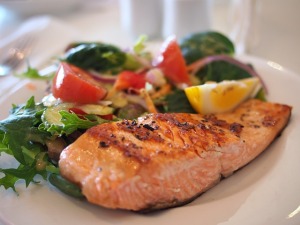Perceptive eating is being aware of our eating habits, slowly savouring what we eat and being mindful of our body’s signals in teaching us when and how much to eat. Here are some tips to get you started:
Ditch ‘Cleaning Your Plate’
One reason we clean our plates is because we hate the thought of wasting food, so here are a couple of ways to prevent wasting food when you’ve had enough to eat:
- Store left over food in the fridge or freezer, and eat it the next day for lunch or whenever you feel hungry. Not only are you reducing food wastage, you are saving money too!
- Serve your meals on smaller plates. It’s a well-known fact that the bigger the plate the more we tend to eat.
- Discover the right portions that suit your appetite. Read more about Portion Sizes
Eat Slowly and Savour!
We live in such a fast paced world that sometimes we can eat so fast we don’t really taste it! Eating too quickly can lead to overeating, as it doesn’t give our bodies time to register feelings of fullness.
It is common for people to eat high fat and/or sugar foods really quickly because they feel a bit guilty. If you really feel like eating something, that’s your choice so don’t beat yourself up for it!
Slow down, and savour your every morsel. Take in the moment and enjoy the texture, aroma, flavour of each bite. Enjoy your food at a slow pace and you will find you’ll need less of it to feel satisfied.
Hunger – Friend or Foe?
Short-term hunger is a natural physiological process that helps us know exactly when and how much to eat to keep our bodies functioning normally.
Before food even touches your lips, hunger triggers the release of essential enzymes and hormones in anticipation of the digestion and absorption of nutrients from food.
Hunger should be embraced as a positive sign that your body is preparing to receive food!
Although hunger is a natural process, it can turn into a roaring beast if not kept under control…
Hunger/Fullness Scale
The below Hunger/Fullness Scale can help us to listen to our body’s hunger and fullness signals.
| Rating | Hunger/Fullness Scale | |
| 10 |
|
|
| 9 |
|
|
| 8 |
|
|
| 7 |
|
|
| 6 |
|
|
| 5 |
|
|
| 4 |
|
|
| 3 |
|
|
| 2 |
|
|
| 1 |
|
Source: www.move.va.gov
Avoid feeling over-hungry
Avoid feeling 1 or 2 on the Hunger/Fullness Scale by having small, regular meals throughout the day.
 Include foods high in protein (e.g. meat, fish, eggs, legumes) and fibre (e.g. whole grain foods, legumes, fruit, vegetables).
Include foods high in protein (e.g. meat, fish, eggs, legumes) and fibre (e.g. whole grain foods, legumes, fruit, vegetables).
These foods will keep you satisfied for longer and prevent you feeling over-hungry between meals. Read more about Portion Sizes to help choose the right amounts for you.
Eat when Hungry
Listen to your body and eat when you feel a hunger rating of about 3 or 4 on the Hunger/Fullness Scale.
Thirst can often be confused with hunger signals. If unsure, drink a glass of water first and wait 10 mins to see if those feelings pass.
Stop eating when satisfied, not stuffed!
It is important to satisfy your hunger at mealtimes but not feel too full.
It’s good to aim for a fullness rating of between 5 and 7 on the Hunger/Fullness Scale.
Eating slowly and controlling portion sizes can help, because our bodies take a little while to register these feelings of fullness.
Reduce Non-hungry Eating
There are lots of reasons why we eat when we are not hungry.
Sometimes we keep eating when we are not hungry because our minds are focused on other things, like watching a movie.
Tip: If you are having a snack, put aside a set portion rather than eating straight from the packet or container.
There are times we find ourselves looking in the fridge or the pantry due to an emotional trigger. We might feel bored, lonely, anxious, stressed or even happy! It’s also very easy to get into a daily routine and just eat because the clock says so, or because we are socialising.
If you succumb to non-hungry eating, instead of beating yourself up about it, use it as an opportunity to learn about yourself.
- Learn what triggers your non-hungry eating.
- Think of activities you can do to avoid non-hungry eating e.g. drink water, talk to a friend.
- Find other ways to provide comfort or a reward that does not involve food.
Write down your thoughts as a reminder of these events and record your journey.

